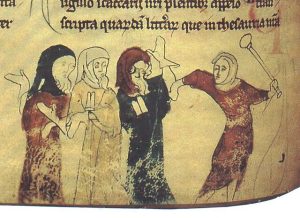The State and the Jews—Expulsion

Miniature showing the expulsion of Jews following the Edict of Expulsion by Edward I of England (July 18, 1290).
Local expulsions began in northern France in the late twelfth century. Toward the end of the thirteenth century, the new tendency accelerated. In 1290, Jews were expelled from England, and in 1306 the same fate befell the Jews of royal France, which now stretched from the Mediterranean Sea all the way northward. Expulsions recurred throughout Europe during the fourteenth and fifteenth centuries, with Jews banished recurrently from diverse domains. In some instances, these Jews were recalled; in other instances the banishment became permanent. The culminating expulsions of our period took place on the Iberian peninsula in 1492 and 1497. The Jewish communities expelled
at this point were among the very oldest in western Christendom and were deemed by many immune from expulsion That even these oldest of European Jewish communities might be banished reflected the extent to which this new and negative governmental stance became the norm, at least in the most westerly and advanced areas of western Christendom.
In this spate of significant expulsions, rulers who chose to banish their Jews always grounded their edicts of banishment in some alleged misdeeds of the Jews that could not be corrected except through removal of the offending Jews. During the late twelfth, thirteenth, and early fourteenth centuries, the purportedly incorrigible Jewish behavior revolved around money-lending. The unwillingness of the Jews to abandon their nefarious money-lending was the supposed reason for the decision to remove them. While there were often other more mundane factors at work as well, such as the desire for revenue or the need to placate one or another element in society, every expulsion had to be grounded in Jewish misdeed. The final expulsions of our period, from the Spanish kingdoms in 1492 and from Portugal in 1497, were portrayed as the result of the deleterious Jewish impact on the large number of New Christians on the Iberian peninsula. So long as Jews remained—it was claimed—the grievous problem of backsliding into Judaism on the part of these New Christians could not be solved.
Images
Primary Texts
Secondary Texts
- R. Mundill, England’s Jewish Solution- Experiment and Expulsion, 1262-1290 (Cambridge- Cambridge University Press, 1998), 249-285.
- W. Jordan, The French Monarchy and the Jews, (Philadelphia- University of Pennsylvania Press, 1989) 179-259.
- Y. Baer, A History of the Jews in Christian Spain, trans. Louis Schoffman et al. (2 vols.; Philadelphia- Jewish Publication Society), 2-170-243.
- H. Beinart, The Expulsion of the Jews from Spain, trans. J. Green (Oxford- The Littman Library of Jewish Civilization, 2002).
- N. Roth, Conversos, Inquisition, and the Expulsion of the Jews from Spain (Madison- University of Wisconsin Press, 2002), 271-316.
- B. Gampel, The Last Jews on Iberian Soil- Navarrese Jewry 1479/1498 (Berkeley- University of California Press, 1989).
Videos
What do you want to know?
Ask our AI widget and get answers from this website